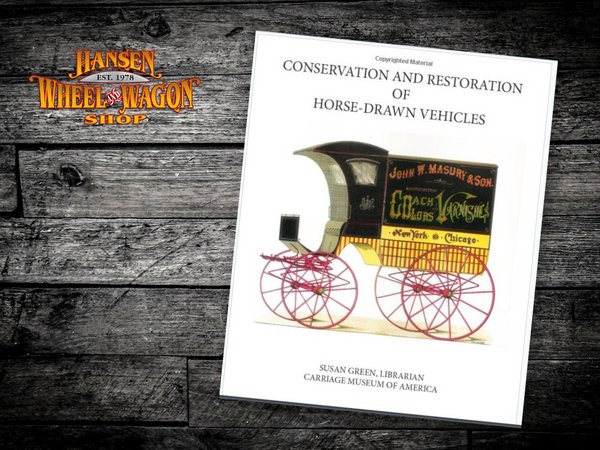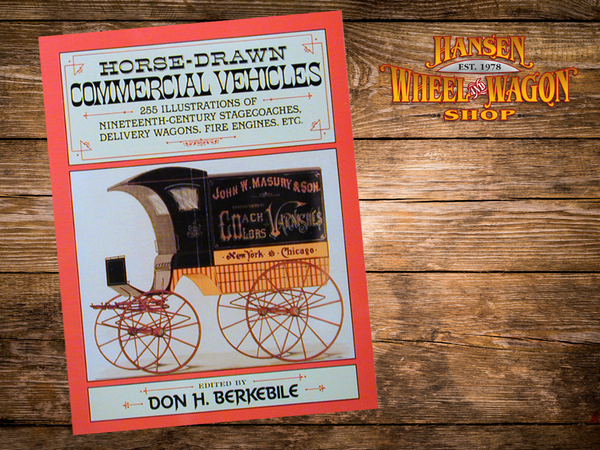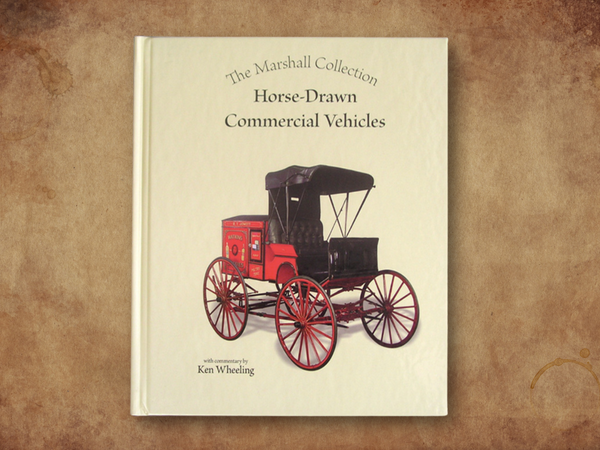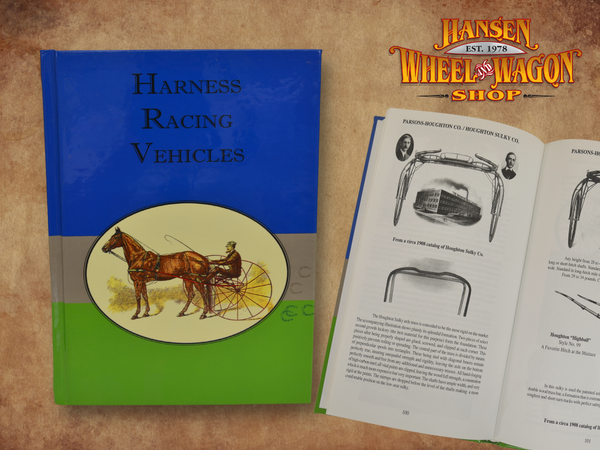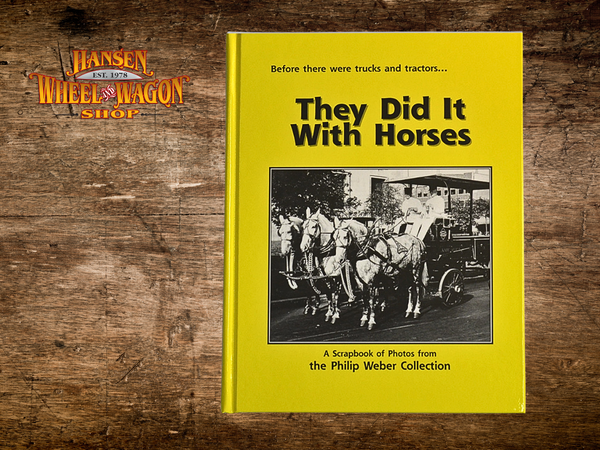The purpose of this book is to help the owners of a horse-drawn vehicle conserve and/or restore their vehicle in order to enhance its value or conserve an irreplaceable historical artifact.
Conserving and restoring a horse-drawn vehicle is a complex undertaking that requires the skills of a wide variety of artisans and craftsman knowledgeable in crafts that are no longer widely practiced or well understood.
Any deviation from the materials or structures used in the original design drastically reduce the monetary and historical value of the vehicle.
This book, therefore, sets out to define the levels of conservation and restoration, the specific steps involved in restoration, the sources for materials and special tools necessary for the work, and most important, names of some of the craftsmen and artisans skilled in the special talents required to produce excellent results.
In addition to the steps involved in conservation and restoration, the book provides some historical background on the design, engineering, and manufacture of horse-drawn vehicles to help the present owner understand the value of proper conservation or restoration, and gain an appreciation for the ingenuity and brilliant skills the original builders exercised in producing his vehicle.
Specifications
- 8 1/2" X 11"
- 230 pages
- Softcover
Contents:
INTRODUCTION
- Background
- Art And Skill Of Restoration
- Where To Begin?
- Your Ultimate Goal
CHAPTER 1- RESEARCH AND RECORDING
- Vehicles Without A Maker's Mark
- Searching Patents
- Vehicles With Maker's Name
SECTION 1- CONSERVATION
CHAPTER 2- GUIDELINES FOR SELECTING A CONSERVATOR
- What is A Conservator?
- FAIC Conservation Services Referral System
- What Questions To Ask Potential Conservators
- What To Expect
- Exercising Caution
- Points To Remember When Selecting A Conservator
CHAPTER 3- CONSERVATION TREATMENT OF HORSE-DRAWN VEHICLES
- Pitfalls Of Restoration
- Conservation To The Rescue
- Self Treatment Versus Professional Conservation Treatment
- What Is Conservation?
- Conservation Ethics
- Integrity Of The Object
- Stable, Reversible Materials
- Documentation
- Single Standard
- Uniqueness
- Educational Responsibility
- Carriage Technology
- Causes/Prevention Of Deterioration
- Composite Object
- Before Treatment Documentation
- Structure
- Paint Stabilization
- Varnish Cleaning
- Varnish Removal
- Inpainting Losses
- Protective Coatings
- Overpainting
- Metal Components
- Upholstery
- Other Attachments
- After Treatment Documentation
- Routine Maintenance
- Dusting
- Dust Covers
- Varnish/Paint Maintenance
- Nicks And Scratches
- Summary
- Supply Reource List
CHAPTER 4- TECHNICAL EXAMINATION AND MICROSCOPIC ANALYSIS OF PAINTED HORSE-DRAWN VEHICLES
- Surface Examination
- Investigating Finish History
- Determining Physical Properties
- Studying Composition
CHAPTER 5- VARNISH FOR HORSE-DRAWN VEHICLES
- Copal
- Linseed Oil
- Properties And Composition Of Linseed Oil
- Turpentine
- Properties And composition Of turpentine
- Driers
- Varnish Making
- Different Recipes For Varnishes
- General Considerations
- Bibliography
SECTION II- RESTORATION
CHAPTER 6- AXLES
- How To Make And Use An Axle Gauge
- Axle Manufacture
- Axle Types
- Collinge Axle
- Mail Axles
- Bearing Axles
- Plain Axles
- Wooden Axles
- Laying Out Wood Wagon Axles
- Inspecting The Axles Before Buying and Restoration
- Bibliography
CHAPTER7- WHEELS
- Patent Wheels
- Getting Wheel Work done
- Dish In Wheels
- Hubs
- Restoration Hubs
- Spokes
- Felloes/Rims
- Tires
- Rubber Tires
- Color of Rubber Tires
- Bibliography
CHAPTER 8- SPRINGS
- Taking Springs Apart
- Having New Springs Made
- Thickness Of Springs
- Effects Of Stress on Carriage Springs With Comments On The Heat Treatment Of Spring Steel
- Faults In Spring Fixing
- Heat Treatment In General
- Heat Treatment Of Spring Steel
- Spring Manufacturing
- Modern Spring Sizes
- Subject Of Leaf Spring Fatigue
- Bibliography
CHAPTER 9- PANELS
- Beading And The Designing Of The Back Panels Of Bodies
- Panels For Painted Vehicles
- Natural Wood Panels
- Different Methods Of Applying Panels
- Replacing A Top Quarter Panel
- Replacing A Top Quarter Panel
- Replacing Reed Moldings
- Brass Bead Molding
- Replacing Lower Quarter Panels That Have A Curve Edge That Fits Into A Rabbet
- Replacing Rear Curved Panels Of Coaches that Have a Rabbet
- Bending Panels
- Replacing A Curved Back Panel In A Rabbet
- Laminating Thin Layers
- Cabinet Makers Paneling
- Veneering Or Skinning
- Repairing Panels By Inlaid
- Bibliography
CHAPTER 10- PREPARING FOR PAINTING
- Getting Started
- Disassembling
- Tips For Removing Rusty Screws
- Gluing
- Paint Removal
- Paint Remover
- Decontaminating
- Bleaching
- Cleaning The Metal
- Cleaning Small Metal Pieces
- Sanding
- Preparing The Wood
- Finishing Springs
- Finish
- Bibliography
CHAPTER 11- BRUSH PAINTING
- The Brush
- Brush Care
- Primer Coats
- Color
- Painting Wheels
- Varnish
- Applying Varnish
- Glaze Coats
- Getting Ready To Varnish
- Some Problems Of Varnish
- Bibliography
CHAPTER 12- SPRAY PAINTING
- Equipment Needed
- Preparation
CHAPTER 13- COLORS
- Corning Type Top Wagon
- Cabriolet Or Panel Boot Victoria
- Brougham
- Landau
- Surrey
- Rumble Seat Basket Phaeton
- Dog Cart
- Wagonette Break
- Private Coach Or Park Drag
- Black Parts
- Natural Wood Carriages
- Bibliography
- Paint Color List
CHAPTER 14- STRIPING, SCROLLING AND ORNAMENTING
- Striping
- Transfers
- Modern Transfer Ornaments
- Stenciling
- Gilding
- Bibliography
CHAPTER 15- CARRIAGE TRIMMING MATERIALS
- Tools
- Sewing Machine
- Materials
- Bedford Cord
- Broadcloth
- Plush
- Tapestry Cloth
- Whipcord
- Camels Hair
- Luxury Fabrics
- Leather
- Patent Leather
- Gum Drill And Macintosh Cloth
- Artificial Leather
- Carriage Laces
- Stuffing Materials
- Polyurethane Foam
- Floor Coverings
- Fringes
CHAPTER 16- UPHOLSTERY
- Laying Out
- Seat Falls
- Door Trimming
- Shafts
- Poles
- Bibliography
- Splinter Bars
- Valances For Seat Borders
- Valances For Folding Tops
- Some Suggestions For Clean-Up And Repair Of Old Folding Tops
CHAPTER 17- LAMPS
- Lamp Covers
- Obtain The "Correct" Lamps
- Evaluating Lamps
- Parts Of A Lamp
- Restoration Plan
- Accomplishing The Restoration
- Hints
- Use, Storage And Preservation
CHAPTER 18- WICKER AND CANE WORK
- Imitation Cane-Work For Painted Carriage Panels
- Sham-Caning
- Bibliography
- Imitation Cane-Work Glued On
- Bibliography
- Modern Method Of Cane-Work
- Routing The Cane-Work
- Procedure
- Woven Cane Work For Seats
- Wicker Work
- Willow
- Reed
- Bibliography
MUSEUMS
BIBLIOGRAPHY
- Carriage Journal Articles
- Book List
SERVICES, SUPPLIES AND RESOURCES
INDEX
Shipping
Shipping Information:
-
Ships via Media Mail -only available for plans and books
-
Flat rate: $13
-
If you’re ordering multiple items, shipping costs may be adjusted or partially refunded based on final weight and packaging.
-
Flat-rate shipping applies to orders within the continental U.S.
For international orders, if you check out using the flat-rate shipping option, we will notify you of any difference in cost and provide a secure link to pay any additional shipping charges, if necessary. Please note that any applicable taxes, duties, or import fees are the responsibility of the customer. -
Contact us for a custom quote!
If you're curious about international shipping costs or prefer a different carrier, feel free to reach out before checkout—we're happy to provide a custom quote.
Please note: Shipping occurs on business days (Monday–Friday, 8:00 AM–4:30 PM). Weekends and holidays may impact delivery time.

